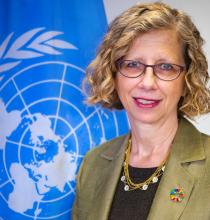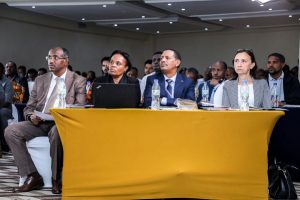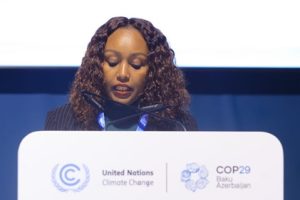
BY DIRRIBA TESHOME
The World Sustainable Development Summit 2021 on ‘Redefining our Common Future: Safe and Secure Environment for All’ facilitated by the Energy and Resources Institute (TERI) was held recently under the shadow of the tragedy in Uttarakhand.
The Executive Director of the United Nations Environment Program (UNEP) Inger Andersen delivered a speech that showcased a new approach to the climate change resilience on the summit.
As we all know, the Intergovernmental Panel on Climate Change warned us that glacier melt would happen as temperatures rose; she pronounced adding: “We know that human activities across the world, including in Uttarakhand, have degraded our landscapes. And on a larger scale, we know that degradation of nature can drive disasters and contribute to pandemics, such as COVID-19”
The three planetary crises of climate change, nature and biodiversity loss, and pollution and waste are increasing the frequency and intensity of events that claim lives and destroy livelihoods, communities and economies; she listed considering that all are known to everyone. As a reason she insisted: “We know we must act.”
As today’s plenary session acknowledges, unsustainable consumption and production is at the heart of these crises; maintaining the world’s living standards with current economic systems would require 1.6 Earths, she put it in her own words with further elaboration: “Two-thirds of all greenhouse gas emissions are linked to private households.
As the world moves to ten billion people, and as we work hard to end poverty and raise incomes, we will see more demand on dwindling resources, more emissions and more waste.”
To act responsibly and to avoid pushing the planet to breaking point, she underscored what is required to be done. “We need global sustainable consumption and production (SCP) and circular economies. Today, I want to suggest three ways in which we can make this transition happen at pace and scale.”
First, prioritize SCP and the circular economy in post-pandemic recovery. A sustainable pandemic recovery offers a huge opportunity to get policies in place that support the Paris Agreement, the biodiversity agenda and the Sustainable Development Goals.
The UNEP Emissions Gap Report, for example, found that a global green recovery could cut 25 per cent of 2030 emissions; she called on the need to bring SCP and circular economy to the front of every action.
UNEP Executive Director Inger Anderson also applauded: “India’s recovery package of around USD 280 billion provides a ready opportunity to invest in the circular economy.
There are opportunities in every sector – from construction to food and agriculture to mining and energy. For example, practices such as remanufacturing, refurbishment, repair, and re-use could cut industrial waste by over 80 per cent in some of these sectors.”
Innovation will be crucial; and invention is something India excels at, she pronounced adding: “Just one recent example is the use of personal protective equipment (PPE) scrap to develop low-cost bedroll mattresses.”
India is also forward thinking, as reflected in the Task Force on Sustainable Public Procurement, the Draft National Resource Efficiency Policy and the draft Extended Producer Responsibility guidelines; she noted promising: “As India seeks to deliver on its circular aspirations, UNEP will continue to extend its support.”
Second, build on the recovery momentum through the climate and biodiversity agendas. A sustainable and green recovery would give us a shove in the right direction. “But we must ensure change is guided by, and drives, globally agreed goals.” She insists the leaders.
2021 is a crucial year in this regard; and more than 126 countries have now committed to net-zero targets by 2050; she counted with further compulsion: “And here let me invite and urge the government of India to join the net-zero clubs.
But the fine print matters and matters greatly. The climate COP is an opportunity to submit detailed ambitious Nationally Determined Contributions (NDCs) and these must include clear plans on SCP and the circular economy.”
When nations meet in Kunming, China, at the COP15 for biodiversity, to create a post-2020 biodiversity framework, the world is looking for an ambitious agenda with clear, measurable targets as well as clear means of implementation.
“As our consumption habits are key drivers of land conversion and biodiversity loss, SCP and circular economies are crucial enablers of the post-2020 biodiversity framework. We need buy-in from every sector, every business and every individual.
And I stress here on business because the full backing of the business and finance sectors is a prerequisite for tackling the three planetary crises.” She underscores the crucial roles of the businesses in climate resilience.
Third, 2021 must be the year that we connect dots and draw lines of action in multilateral governance. 2021 must be the year of synergy; and it is vital that the three Rio Conventions – on biodiversity, on climate change and on desertification – unite fragmented environmental governance and in so doing, contribute to the sustainable development goals.
“I look to India’s leadership and environmental stewardship in this regard as the country holds the presidency of the Convention on Migratory Species (CMS), and the Convention to Combat Desertification (UNCCD), and will assume the presidency of the G20 in 2023;” she hoped.
In conclusion, these three points are not exhaustive; “There is so much more we can do. What is crucial to remember is that a global move to circular economies is a smart economic decision as well as the key to ending the three planetary crises.
In fact, such a global move could generate USD 4.5 trillion in annual economic output by 2030;” she noted. SCP and circular economies to augment safe, secure environment for all
The Ethiopian Herald February 16/2021





